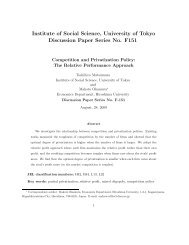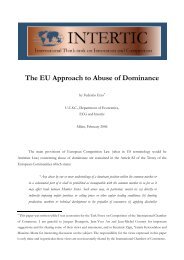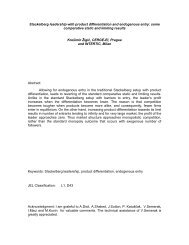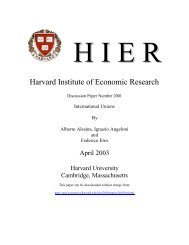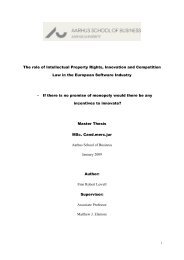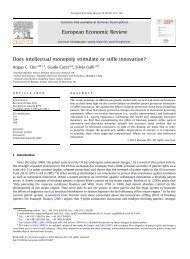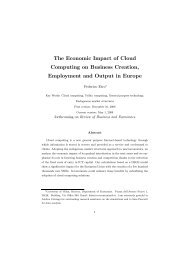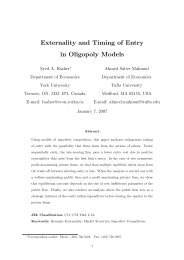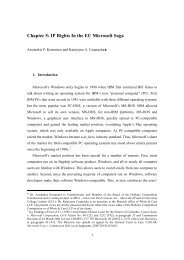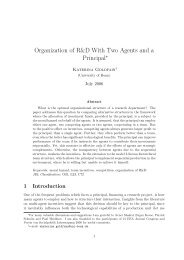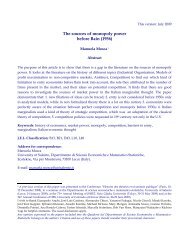Oligopolistic Cost Innovation, Stock Markets, and ... - Intertic
Oligopolistic Cost Innovation, Stock Markets, and ... - Intertic
Oligopolistic Cost Innovation, Stock Markets, and ... - Intertic
Create successful ePaper yourself
Turn your PDF publications into a flip-book with our unique Google optimized e-Paper software.
link between the degree of competitiveness <strong>and</strong> growth can be either positive or negative,<br />
depending critically on the elasticity of dem<strong>and</strong> for the oligopolistic good.<br />
With a low<br />
elasticity of dem<strong>and</strong>, more competition reduces growth. With a high elasticity of dem<strong>and</strong>,<br />
the inverted-U relationship between product-market competition <strong>and</strong> growth documented<br />
to hold in empirical work by Geroski (1995), Nickell (1996), Blundell et. al. (1995) <strong>and</strong><br />
(1999), <strong>and</strong> Aghion et. al. (2002) is implied by the model. With low competition <strong>and</strong> a high<br />
consumer dem<strong>and</strong>, firms invest more in innovation, despite the fact that knowledge spillovers<br />
also make their competitors stronger: higher innovation investment boosts consumer dem<strong>and</strong><br />
<strong>and</strong> firms can make higher profits. Above a level of competition, firms choose to free-ride<br />
on the investment of others: a typical commons problem dominates, <strong>and</strong> investment <strong>and</strong><br />
growth fall. The elasticity of dem<strong>and</strong> for oligopolistic goods, the key parameter for lin king<br />
te model with the empirical facts, is driven by consumer preferences. In particular, with<br />
iso-elastic utility functions, a high elasticity of intertemporal substitution of goods is behind<br />
a higher elasticity of dem<strong>and</strong> for the oligopolistic goods.<br />
(c) There is a tight link between industry growth <strong>and</strong> long-run stock market trends. With<br />
respect to the short run, an unanticipated permanent entry or exit of firms can lead to<br />
massive temporary-adjustment changes in the returns of stocks. The economy adjusts from<br />
a previous market structure to a new one with consumers spending a different share of their<br />
income on oligopolistic goods <strong>and</strong> the value of the stock market rationally adjusts fast to<br />
reflect such changes. Critical in determining the magnitude of a temporary stock-market<br />
rise or fall, are the forces determining Tobin’s q in environments with alternative market<br />
structures: Tobin’s q, the ratio between the cost for acquiring new knowledge <strong>and</strong> the ability<br />
of this investment to generate future profits is strongly affected by the spillover of knowledge.<br />
Although the existence <strong>and</strong> nature of equilibrium of the model is tackled analytically,<br />
6



